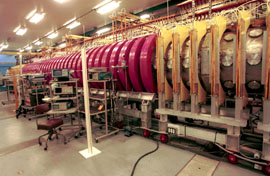|
The LArge Plasma Device (LAPD) is the main
experimental device at UCLA's Basic Plasma Science
Facility (BAPSF). LAPD is an 18 m long, 1 m
diameter cylindrical vacuum chamber, surrounded by 90 magnetic field
coils. Plasmas are generated using a DC discharge. To produce the
discharge, a large area (0.75 m diameter) heated barium oxide
coated nickel cathode is used along with a molybdenum mesh anode (0.55
m away). A 4 F capacitor bank is connected between the
anode and cathode and is used to generate a discharge current of up to
20 kA using a set of high-power IGBT switches. Uniform
magnetized plasmas are created in LAPD with a repetition rate of 1
Hz and pulse lengths of 1-10 ms. Magnetic field
strengths of 200 G to 4 kG are achievable in LAPD. The
available working gases include helium, neon, argon, and
hydrogen. While the parameter regime is not directly fusion relevant,
incredibly detailed measurements can be made in LAPD. This allows us
to significantly challenge the predictive capability of simulation
codes and ultimately to advance our theoretical understanding of the
basic plasma physics underlying important phenomena in fusion
reactors.
The machine has excellent access for probes and optics. There are 450
radial ports; 64 of which are rectangular, allowing a nearly 360
degree view of the plasma in 8 locations along the machine length.
There are sixty rotatable "ball valve" flanges, which allow probe
placement anywhere in the plasma volume between two axial field
magnets. Two portable cryopump vacuum stations allow for evacuation
of interlocks attached to these valves so that probes can be moved in
and out of the system without breaking vacuum. The machine is
outfitted with several computer controlled stepping motors, which can
move probes with submillimeter accuracy throughout the plasma volume.
Large probes and antennas can be introduced through the rectangular
ports at seven locations using custom-built square valves and two
additional cryopumps. Data is acquired with 12 channels of 8 bit, 5
GS/s digitizers, and 32 channels of 14-bit, 100 MS/s
digitizers which are optically coupled to the data acquisition system.
Eight channels of 80 MHz analog optical coupling are available
for signal transport. Diagnostics include a 56 GHz microwave
interferometer for line-integrated density measurements. Optical
diagnostics include laser-induced-fluorescence for measurement of ion
temperatures and drifts using a 500 kHz bandwidth low power (1
W) ring laser and a large (1 GHz) bandwidth 15 MW
pulsed dye laser. The lab has a 150 MW (7 ns Gaussian
pulse) Nd-Yag laser with a 1 Hz repetition rate for production of
dense plasmas within the background cathode-produced plasma. For 20
kHz-200 MHz wave launching, the laboratory has two high
power (2.5 kW) amplifiers and a handmade 20 kW tuned RF
amplifier. A 250 kW pulsed source is available to launch high
frequency (8.5-9.5 GHz) waves. The lab also has two arbitrary
waveform generators, several high quality digital oscilloscopes, a
spectrum analyzer, a network analyzer, a 10 ns image
intensified digital camera, and several monitor scopes. The LAPD
device is housed in the Science and Technology Research building at
UCLA. The building was constructed to support large experiments and
has 15 MW of power available to experiments. The building
network is connected to the campus by a fiber based ATM network.
|

